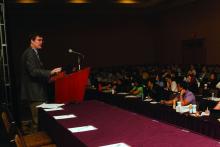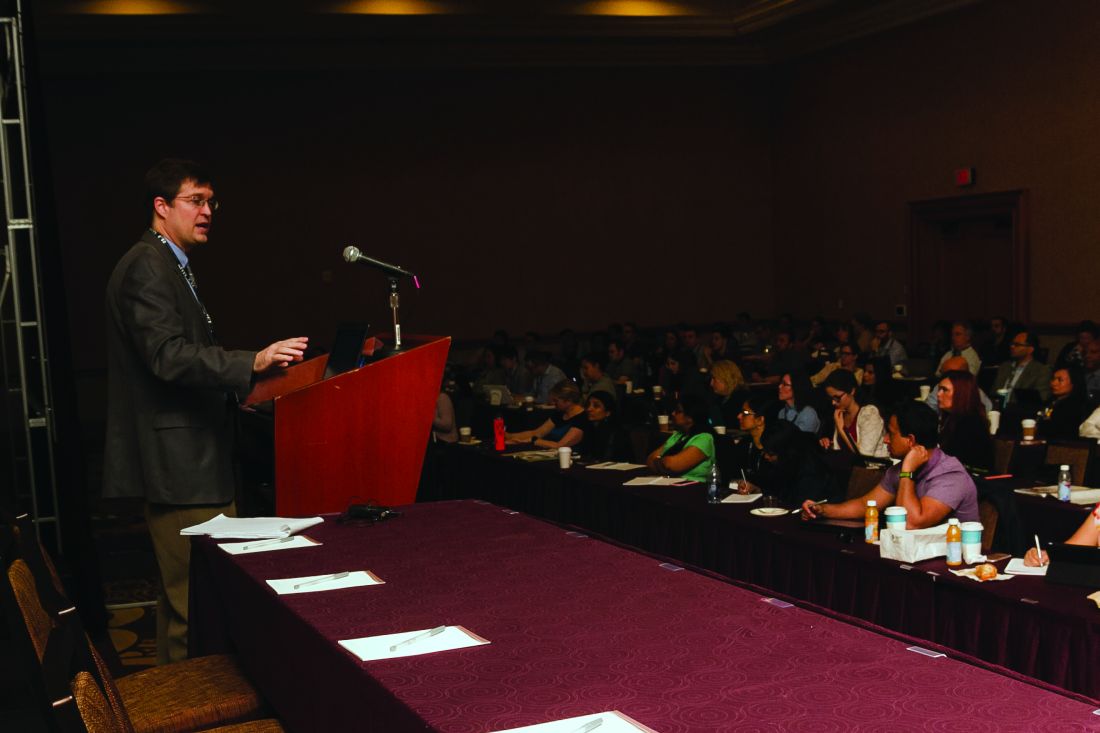User login
No hands went up when Glenn Wortmann, MD, chief of infectious diseases at MedStar Washington Hospital Center, asked whether any of the hospitalists in front of him had handled any cases of Candida auris, a kind of yeast that is highly resistant to several potent antifungals and, in some cases, has been found to be resistant to every antifungal thrown at it.
They might not have seen this dreadful bug, first identified in Japan in 2009, yet. But they will soon, Dr. Wortmann said.
James Pile, MD, SFHM, a pre-course director and associate professor of internal medicine at Case Western Reserve University, Cleveland, said he expected that most of those who signed up already knew quite a bit about I.D. issues, but the point of the course was to go deeper.
“Our goal was to find the sweet spot in what they don’t know or need a refresher on,” he said.
In his talk, he focused on infectious disease emergencies – such as infective endocarditis – which hospitalists may not see as often but that “we just have to get right when we do see them because the stakes are very high.”
He covered spinal epidural abscess, bacterial meningitis, and soft tissue necrotizing infections, saying that a crucial element in managing these cases is to seriously consider them a possibility in the first place. He also recommended having a low threshold for obtaining a surgical consultation, a CT scan, or both in patients with what appears to be severe cellulitis.
John Sanders, MD, MPH, head of infectious diseases at Wake Forest Baptist Health, Winston-Salem, N.C., dug into the nitty-gritty of C. difficile infections, touching on the possible role of acid suppressants, especially proton pump inhibitors, in the increasing incidence of these infections. The news wasn’t all bad: He also discussed emerging therapies, such as CRS3123 – a narrow-spectrum antibiotic that inhibits protein synthesis, toxin production, and sporulation – and monoclonal antibodies, which have been shown to lower recurrence rates when used with antibiotics.
The keys to controlling C. diff infections, he said, are hand-washing, remembering that the spores are resistant to ethanol, limiting fluoroquinolone use, and isolating patients with active infections.
Ultraviolet lighting for C. diff control is a gray area, he said.
“The data [are] mixed,” he said. “I think it’s a good idea to do it, and it’s certainly being pushed. But it’s somewhat controversial as to whether it’s cost effective.”
No hands went up when Glenn Wortmann, MD, chief of infectious diseases at MedStar Washington Hospital Center, asked whether any of the hospitalists in front of him had handled any cases of Candida auris, a kind of yeast that is highly resistant to several potent antifungals and, in some cases, has been found to be resistant to every antifungal thrown at it.
They might not have seen this dreadful bug, first identified in Japan in 2009, yet. But they will soon, Dr. Wortmann said.
James Pile, MD, SFHM, a pre-course director and associate professor of internal medicine at Case Western Reserve University, Cleveland, said he expected that most of those who signed up already knew quite a bit about I.D. issues, but the point of the course was to go deeper.
“Our goal was to find the sweet spot in what they don’t know or need a refresher on,” he said.
In his talk, he focused on infectious disease emergencies – such as infective endocarditis – which hospitalists may not see as often but that “we just have to get right when we do see them because the stakes are very high.”
He covered spinal epidural abscess, bacterial meningitis, and soft tissue necrotizing infections, saying that a crucial element in managing these cases is to seriously consider them a possibility in the first place. He also recommended having a low threshold for obtaining a surgical consultation, a CT scan, or both in patients with what appears to be severe cellulitis.
John Sanders, MD, MPH, head of infectious diseases at Wake Forest Baptist Health, Winston-Salem, N.C., dug into the nitty-gritty of C. difficile infections, touching on the possible role of acid suppressants, especially proton pump inhibitors, in the increasing incidence of these infections. The news wasn’t all bad: He also discussed emerging therapies, such as CRS3123 – a narrow-spectrum antibiotic that inhibits protein synthesis, toxin production, and sporulation – and monoclonal antibodies, which have been shown to lower recurrence rates when used with antibiotics.
The keys to controlling C. diff infections, he said, are hand-washing, remembering that the spores are resistant to ethanol, limiting fluoroquinolone use, and isolating patients with active infections.
Ultraviolet lighting for C. diff control is a gray area, he said.
“The data [are] mixed,” he said. “I think it’s a good idea to do it, and it’s certainly being pushed. But it’s somewhat controversial as to whether it’s cost effective.”
No hands went up when Glenn Wortmann, MD, chief of infectious diseases at MedStar Washington Hospital Center, asked whether any of the hospitalists in front of him had handled any cases of Candida auris, a kind of yeast that is highly resistant to several potent antifungals and, in some cases, has been found to be resistant to every antifungal thrown at it.
They might not have seen this dreadful bug, first identified in Japan in 2009, yet. But they will soon, Dr. Wortmann said.
James Pile, MD, SFHM, a pre-course director and associate professor of internal medicine at Case Western Reserve University, Cleveland, said he expected that most of those who signed up already knew quite a bit about I.D. issues, but the point of the course was to go deeper.
“Our goal was to find the sweet spot in what they don’t know or need a refresher on,” he said.
In his talk, he focused on infectious disease emergencies – such as infective endocarditis – which hospitalists may not see as often but that “we just have to get right when we do see them because the stakes are very high.”
He covered spinal epidural abscess, bacterial meningitis, and soft tissue necrotizing infections, saying that a crucial element in managing these cases is to seriously consider them a possibility in the first place. He also recommended having a low threshold for obtaining a surgical consultation, a CT scan, or both in patients with what appears to be severe cellulitis.
John Sanders, MD, MPH, head of infectious diseases at Wake Forest Baptist Health, Winston-Salem, N.C., dug into the nitty-gritty of C. difficile infections, touching on the possible role of acid suppressants, especially proton pump inhibitors, in the increasing incidence of these infections. The news wasn’t all bad: He also discussed emerging therapies, such as CRS3123 – a narrow-spectrum antibiotic that inhibits protein synthesis, toxin production, and sporulation – and monoclonal antibodies, which have been shown to lower recurrence rates when used with antibiotics.
The keys to controlling C. diff infections, he said, are hand-washing, remembering that the spores are resistant to ethanol, limiting fluoroquinolone use, and isolating patients with active infections.
Ultraviolet lighting for C. diff control is a gray area, he said.
“The data [are] mixed,” he said. “I think it’s a good idea to do it, and it’s certainly being pushed. But it’s somewhat controversial as to whether it’s cost effective.”

